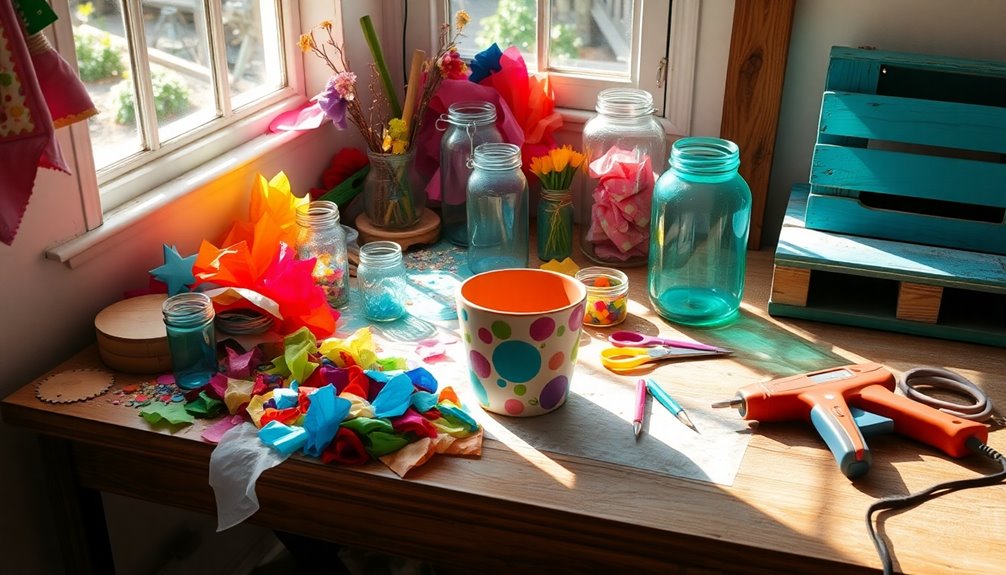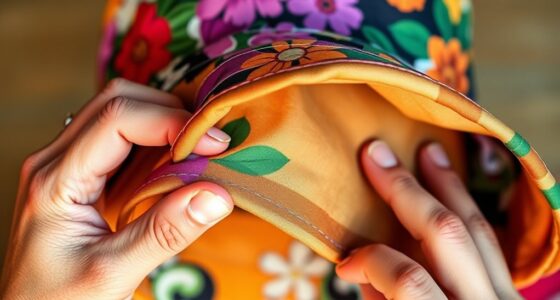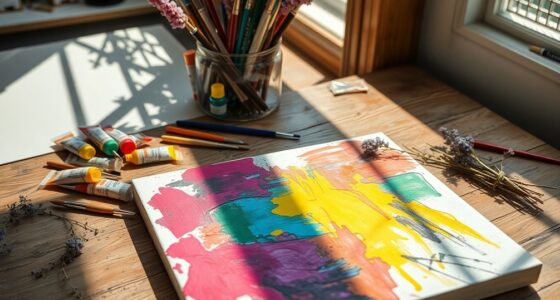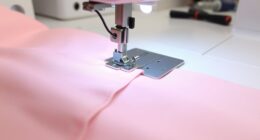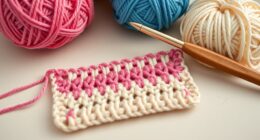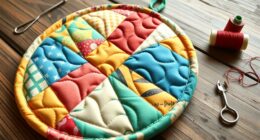Upcycling's a fun way to transform old items into new treasures! Start by selecting lightweight materials like t-shirts or scarves, and try no-sew techniques like fabric glue for easy projects. Consider simple ideas like turning a t-shirt into a tote bag or coasters from fabric scraps. Set up a dedicated workspace to keep your supplies organized. Embrace any mistakes; they can spark creativity. Stick around to discover more project ideas and tips for your upcycling journey!
Key Takeaways
- Start with simple materials like old t-shirts or faded scarves to create projects such as tote bags or pillow covers.
- Use no-sew techniques like fabric glue for easy transformations, allowing beginners to craft without sewing skills.
- Gather extra supplies, such as buttons and patches, to enhance upcycling projects economically and creatively.
- Designate a clutter-free workspace with good lighting to ensure effective organization and efficient crafting.
- Share your creations on social media or join local craft nights to connect with other crafters for inspiration and support.
Understanding the Basics of Upcycling
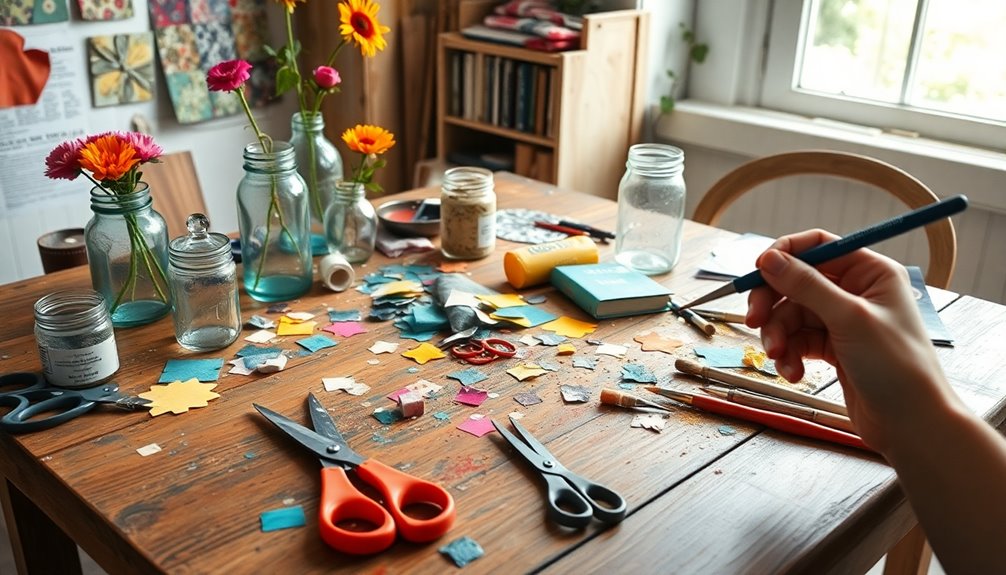
Upcycling is a creative way to breathe new life into items you might otherwise toss aside. It involves transforming old clothes and other materials into new, useful products without breaking them down, unlike recycling.
If you're new to this, start with simple items like holey t-shirts or faded scarves. These projects allow you to practice your creativity while using easily available materials.
Social media platforms like Instagram and TikTok offer a treasure trove of inspiration through hashtags like #upcycle, showcasing diverse projects that can spark your imagination.
Remember, flexibility is key in upcycling; embrace mistakes as they can lead to unexpected and unique outcomes. Additionally, engaging in upcycling can contribute to your overall mental well-being, promoting mindfulness and satisfaction through creative expression.
This beginner's guide to upcycling encourages experimentation while promoting sustainability and resourcefulness.
Selecting the Right Materials for Your Project
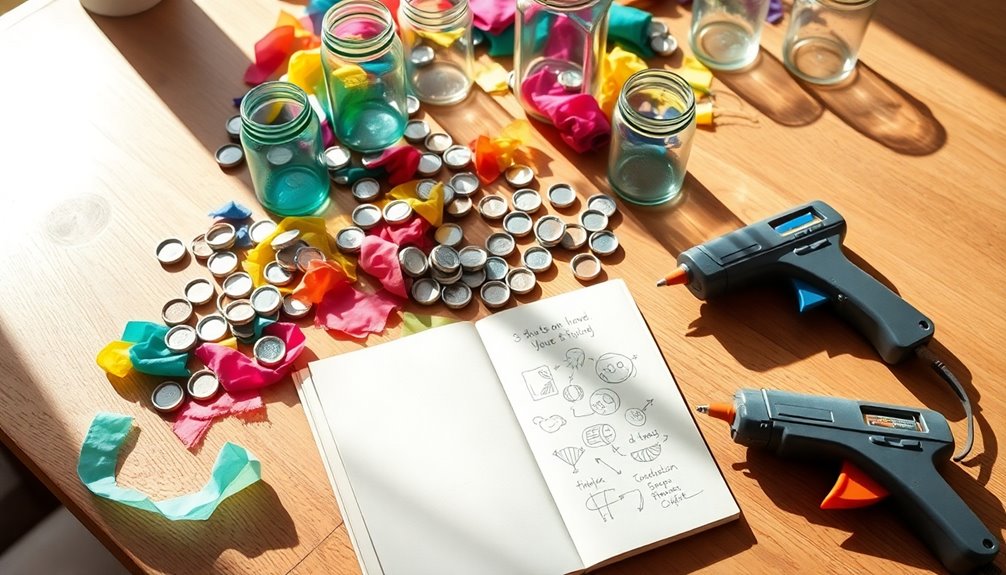
Choosing the right materials is essential for a successful upcycling project. Start by gathering clothing items you no longer wear, like old t-shirts or faded scarves. These can serve as excellent base materials for transformation.
Thrift stores are great for finding secondhand options without spending much, allowing you to express your creativity. Look for items that require minimal tools; lightweight cotton is perfect for simple projects, while sturdier denim is ideal for stronger designs.
Pay attention to texture and durability to choose the best fabric for your project. Additionally, gather extra supplies like buttons or fabric glue from home or secondhand sources to enhance your upcycling projects without breaking the bank. Incorporating secondhand options into your creations can also support sustainable practices. By selecting materials that are both durable and aesthetically pleasing, you ensure that your creations will last while minimizing environmental impact. Additionally, exploring ecofriendly craft project ideas can inspire creativity and innovation as you repurpose items that might otherwise go to waste. Engaging with these sustainable practices not only benefits the planet but also allows you to develop a unique style that reflects your values.
Simple Upcycling Techniques to Get Started
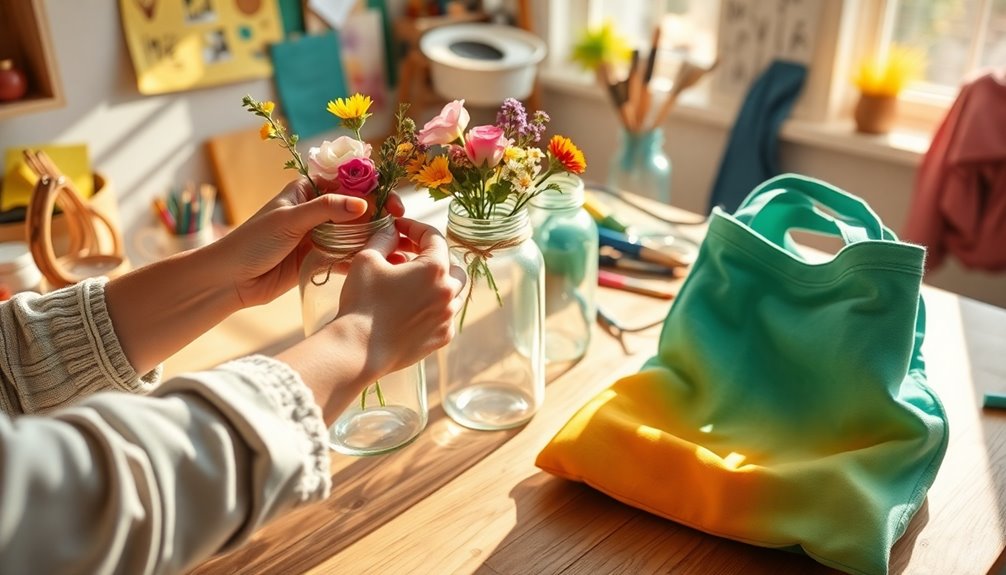
Once you've gathered your materials, it's time to explore some simple techniques that'll help you kick off your upcycling journey. Start with easy-to-upcycle items like old t-shirts or jeans. You can utilize no-sew methods like fabric glue or iron-on patches for unique creations. Visible mending is another fun technique; it repairs holes while adding personality to your clothes. To keep everything organized, consider creating a project planner or using labeled bins for your supplies.
| Technique | Description | Supplies Needed |
|---|---|---|
| No-Sew Techniques | Use glue or patches for easy designs | Fabric glue, patches |
| Visible Mending | Repair holes with decorative stitches | Needle, thread, fabric |
| Thrift Store Finds | Source inexpensive materials | Thrift store items |
Explore hashtags like #upcycle for inspiration!
Creative Project Ideas for Beginners
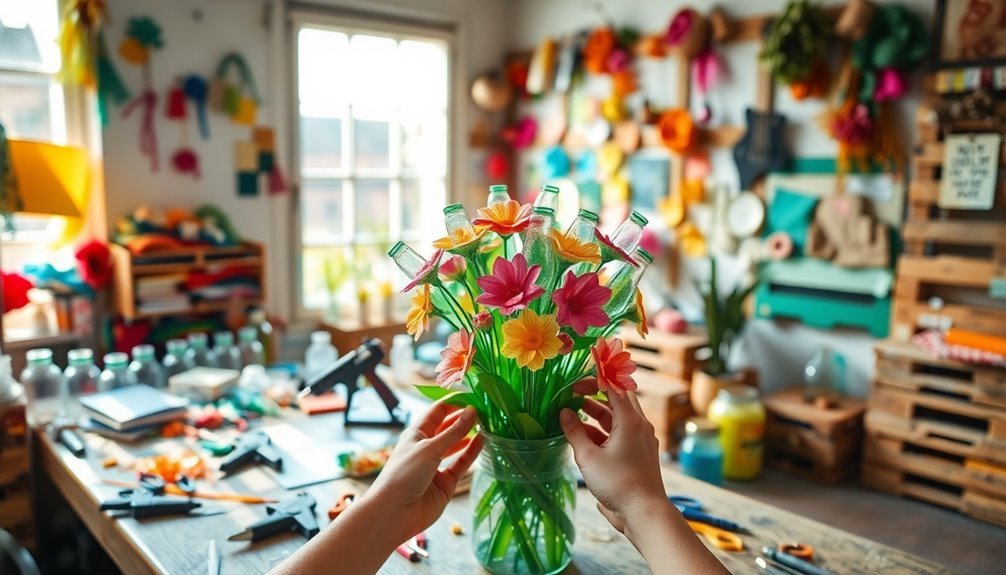
Ready to get creative with your old clothes? Transforming a t-shirt into a tote bag or making a unique headband from fabric scraps are simple projects that kick off your upcycling journey.
Let's explore some fun ideas that not only reduce waste but also add a personal touch to your style!
Easy T-Shirt Transformations
If you've got a pile of old t-shirts gathering dust, you're in luck because transforming them into fun and functional items is easier than you might think.
These easy t-shirt transformations can kick off your upcycling adventures and help you create something new from old things. Here are some simple ideas to get you started:
- Infinity Scarf: Cut and tie your t-shirt for a stylish accessory.
- Head Wrap: Cut into strips and braid or twist for a cute hair solution.
- Tote Bag: Cut off the sleeves for a quick no-sew project.
- Pillow Cover: Tie or sew around a pillow insert for a personalized touch.
Dive into these projects and watch your old t-shirts come to life!
Simple Fabric Scrap Projects
After transforming those old t-shirts, you might find yourself wondering what to do with leftover fabric scraps. Embrace the upcycle challenge and let your creativity shine!
One fun project is making unique coasters by sewing or gluing scraps together, adding a functional touch to your home. You can also create a colorful patchwork pillow cover, giving your decor a new flair.
Small pouches or bags are perfect for organizing items or gifting to friends. Don't forget about hair accessories—repurpose scraps into trendy headbands or scrunchies.
For a festive touch, craft a simple fabric bunting by cutting scraps into triangles and attaching them to a string. These projects will turn old fabric into something fabulous! Additionally, consider using non-toxic materials in your projects to ensure safety and sustainability.
Setting Up Your Workspace for Success
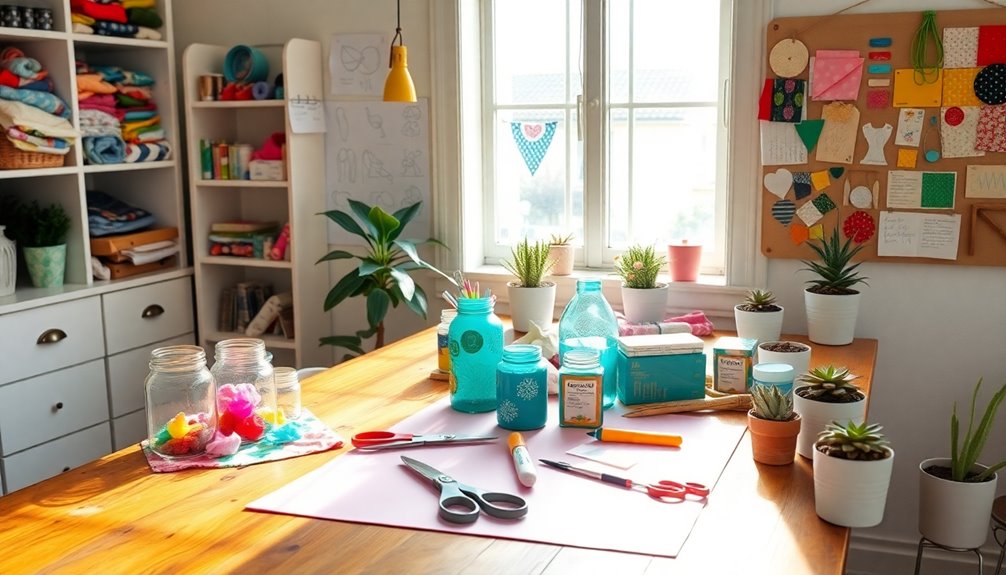
Creating an effective workspace is essential for successful upcycling projects, as a well-organized area can greatly boost your focus and creativity.
To set up your workspace for success, make certain to:
- Designate a clutter-free area in your home.
- Organize materials and tools in containers or on shelves for easy access.
- Guarantee you have good lighting to see details clearly.
- Consider ventilation, especially when using paints or adhesives.
Additionally, ensure you have energy-efficient lighting to enhance visibility while also being mindful of your environmental impact.
Embracing the Creative Process and Sharing Your Work
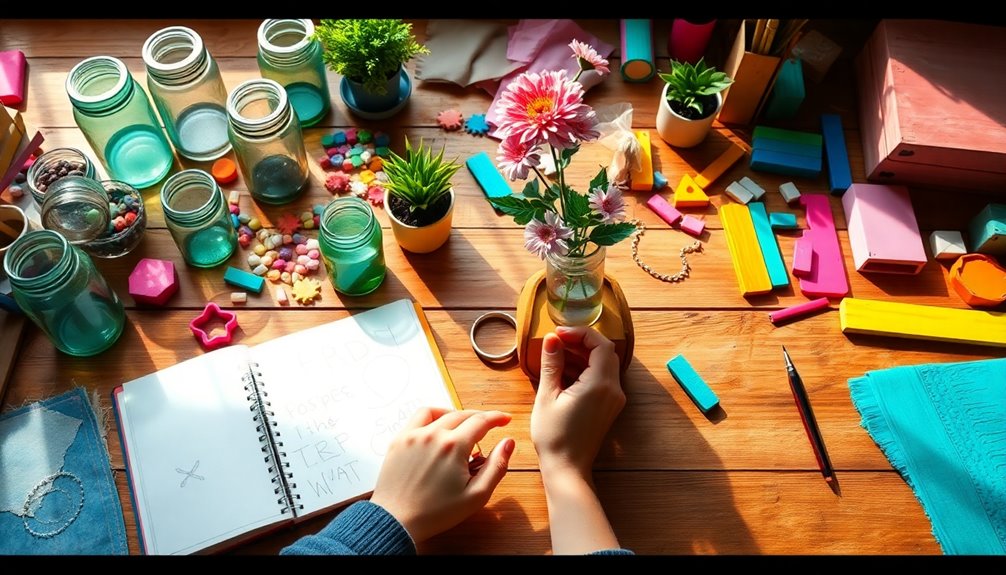
Embracing your unique style in upcycling allows you to celebrate your individuality and craft projects that truly reflect you. By connecting with crafting communities, you can share your creations and gain inspiration from others, creating a vibrant network of like-minded individuals. Additionally, personalizing your projects can enhance overall aesthetic appeal, making your creations stand out even more.
Celebrate Individuality in Upcycling
While upcycling often starts with repurposing materials, it truly flourishes when you allow your personal style to shine through.
Celebrate individuality by embracing the uniqueness of each project. Share your creations on social media, inspiring others and building a community of creativity. Remember, it's okay for things to be hard to find; the beauty lies in your distinct touch.
Here are some ways to showcase your individuality:
- Share before and after photos to highlight your transformations.
- Participate in local upcycling challenges for fresh inspiration.
- Create a DIY handbook or Pinterest board to document your journey.
- Embrace imperfections, focusing on the joy of creation over perfection.
Additionally, engaging in upcycling supports sustainable habits that enhance overall well-being. Your unique perspective makes each project special!
Connect With Crafting Communities
How can connecting with crafting communities elevate your upcycling journey? Engaging with these groups allows you to share your projects, receive valuable feedback, and gain fresh inspiration from others.
Platforms like Instagram and Pinterest, with hashtags like #upcycle, make it easy to connect with fellow crafters and explore new ideas. Participating in local craft nights or workshops strengthens relationships and offers a chance to learn new techniques in a supportive environment.
Sharing before and after photos of your upcycled items not only encourages community engagement but also motivates others to breathe new life into their own projects.
Many crafting communities provide resources, tutorials, and challenges, like the Rebuild Together Upcycle Challenge, inspiring you to think creatively and push your boundaries.
Frequently Asked Questions
How to Upcycle for Beginners?
If you're looking to upcycle as a beginner, start with simple projects like turning an old t-shirt into a tote bag.
Check out Pinterest or Instagram for inspiration using hashtags like #upcycle. Gather basic supplies like scissors and fabric glue, which you can often find at home or thrift stores.
Choose clothing items you no longer wear, and don't hesitate to experiment. Embrace the learning process and let your creativity shine!
What Is the Difference Between Upcycled and Repurposed?
When you're looking at upcycled versus repurposed items, the difference lies in creativity and function.
Upcycled items undergo artistic redesign, transforming their original form into something unique and appealing, like turning an old t-shirt into a tote bag.
On the other hand, repurposed items retain their original structure but are used for a different function, like using that same t-shirt as a cleaning rag.
Both methods promote sustainability, but upcycling requires more craftsmanship.
What Upcycled Items Sell Best?
Did you know that upcycled clothing can sell for up to 50% more than new items?
When it comes to what upcycled items sell best, unique clothing pieces like transformed t-shirts or accessories top the list.
Upcycled furniture with artistic flair also attracts buyers, as do home decor items like denim quilts.
Seasonal upcycled decorations often fly off the shelves during holidays, tapping into the growing trend of sustainable gifting.
Is Selling Upcycled Clothes Legal?
Yes, selling upcycled clothes is generally legal, but you need to follow certain regulations.
Make sure to remove or alter any original brand labels to avoid trademark issues. Be aware of copyright concerns if you use original artwork or logos without permission.
Depending on your location, you might also need to register your business and obtain permits.
Always check the specific policies of the platforms you're selling on to avoid any complications.
Conclusion
Now that you've opened up the art of upcycling, let your imagination soar like a kite in the wind. Remember, each project is a blank canvas waiting for your unique touch. Embrace the journey, and don't shy away from sharing your creations with the world—they could inspire someone else to start their own crafting adventure. So gather your materials, roll up your sleeves, and let the magic of transformation begin! Your next masterpiece is just a few steps away.
